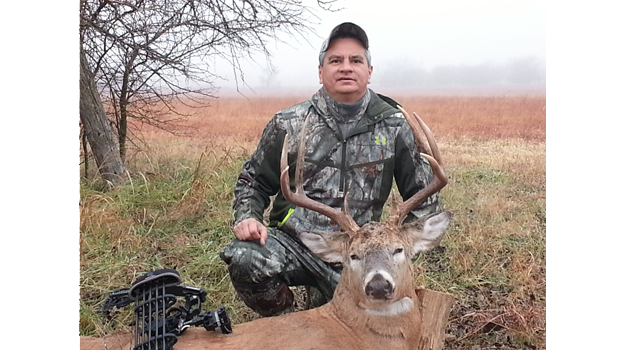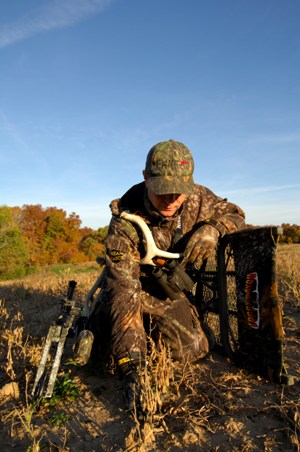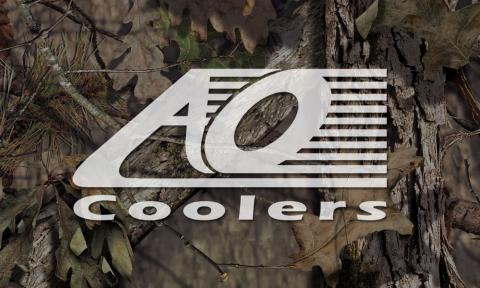
Editor’s Note: Marvin Temple of Nixa, Missouri, has been hunting deer for more than 40 years. He’s been a Mossy Oak Pro ever since the program began. “When the Mossy Oak Treestand pattern first came out in the 1980s, I thought it was an incredible pattern, and I've been wearing it ever since,” Temple says.
I know all types of methods are used to pinpoint older-age class bucks. However, if I locate the deer’s primary food source, I've learned that I’ll find the bucks. I know that many hunters prefer to hunt closer to the bedding area than to the food source, and I’ve tried that tactic a few times. Maybe it didn’t work because of my lack of experience in hunting that way, but I've noticed, if I get too close to a mature bucks’ bedding area, they’ll leave, and I’ll never see them again. So, I prefer to take a stand in a tree or close to the tree where the deer are feeding or hunt the trails between the bedding area and the feeding area.
I've also learned that most hunters prefer to try and bag their bucks at the beginning of bow season, but I prefer to hunt a food source through the end of the season. Late in the year, the deer are usually feeding on cut crops like soybeans, corn and wheat. To sweeten up the places I hunt, I create BioLogic food plot sites close to those crop fields. I like to plant BioLogic’s Maximum, because it provides food all year long for the deer. I plant small food plots as well as large food plots. By planting 1/2-acre food plots, I've learned that often the bucks feel more comfortable feeding there than they do in my large food plots. I think the 1/2-acre food plots are more productive than the large food plots, because the buck can take one step out of thick cover and begin to feed. If he spots danger, he’s only one jump out of the field back into the thick cover. Even if he's farther out in a green field, he may not be more than three jumps to get back into thick cover. I also have several food plots that cover 4-5 acres. Those bigger food plots draw in numbers of does as well as bucks. During the rut, those bigger food plots are often where we see our bucks chasing does.
 I hunt all private lands that a friend or two and I lease – in Missouri, Kansas and Texas. In Missouri, I hunt 400 acres. In Kansas, we have a couple of thousand acres to hunt. In Texas, we have about 1,000 acres to hunt.
I hunt all private lands that a friend or two and I lease – in Missouri, Kansas and Texas. In Missouri, I hunt 400 acres. In Kansas, we have a couple of thousand acres to hunt. In Texas, we have about 1,000 acres to hunt.
My 400 acres in Missouri is broken up by two farms. One of the farms is a little more than 200 acres, and the other farm is a little more than 100 acres. On my Missouri properties, there are quite a few drainage ditches in the fields and some fence rows that the deer travel. One of the areas has CRP land adjacent to it. We hunt the deer coming from the bedding areas in the CRP to the crop fields. The other areas are mainly crop fields where we hunt the ditches and fence rows between the crops.
We hunt the same way in Kansas. The difference in my Missouri hunting and my Kansas hunting is that Kansas doesn’t have many big trees. I hunt the southeastern corner of Kansas that has numbers of hedge thickets and hedgerows. It also has some oak flats, but not as many oak flats as we have to hunt in Missouri. The biggest problem we have in Kansas is not finding older-age class bucks to hunt, but rather locating trees to hunt from that are big enough. Kansas has row crops everywhere.
I haven’t bowhunted much on our Texas property. I gun hunt there more and hunt out of tower blinds.
To learn more about hunting, check out John E. Phillips’ new eBook and print book, “Bowhunting Deer: Mossy Oak Pros Know Bucks and Bows.” You also can download a free Kindle app that enables you to read the book on your iPad, computer or Smartphone.
For information on making jerky from your deer to provide a protein-rich snack, you can download a free book from http://johninthewild.com/free-books.
Day 1: Deer Pattern Me and My Movements as Quickly as I Pattern Them
Tomorrow: Taking a White-Tailed Buck Scoring 156



























